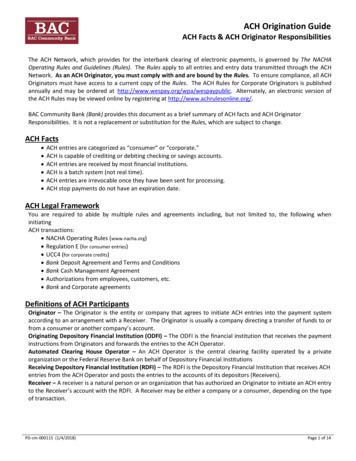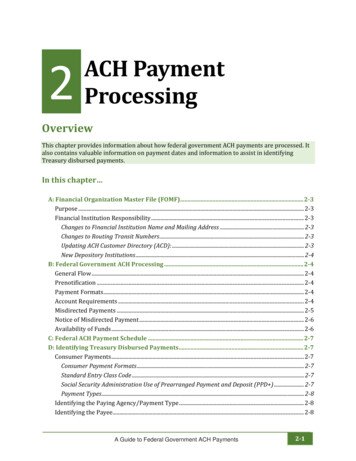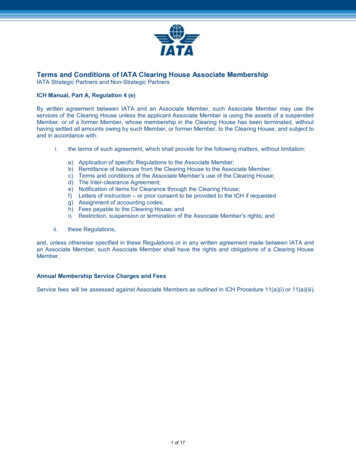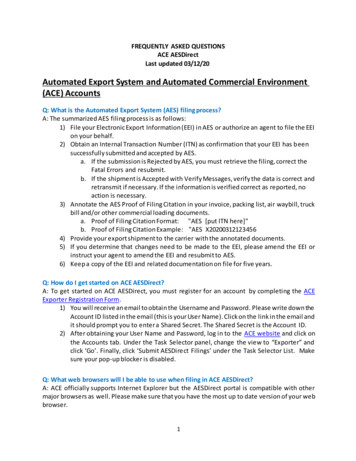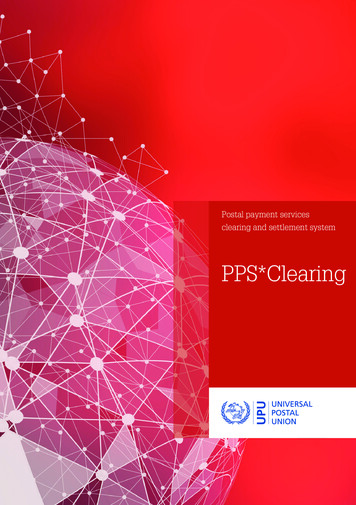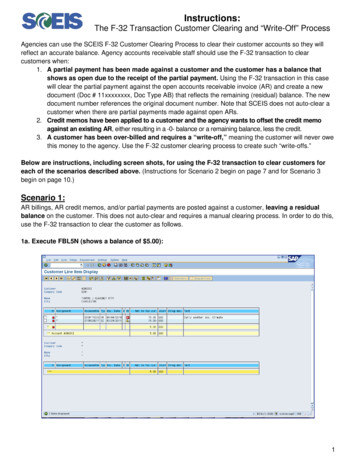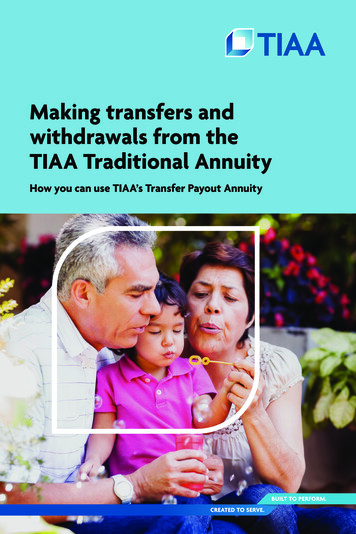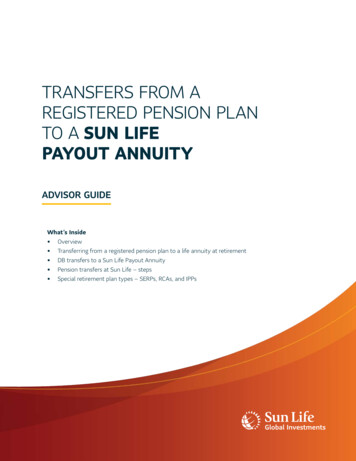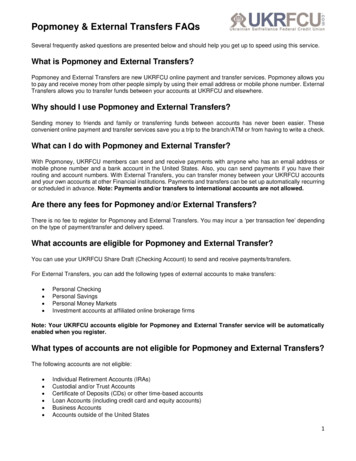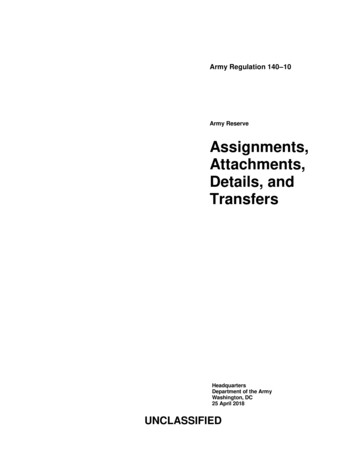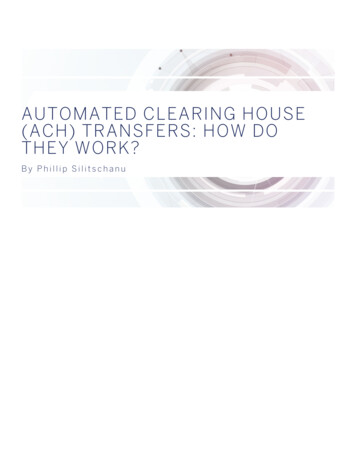
Transcription
AUTOMATED CLEARING HOUSE(ACH) TRANSFERS: HOW DOTHEY WORK?By Phillip Silitschanu
WHAT ARE ACH TRANSFERS?There are numerous ways to transfer funds betweenpersonal and business bank accounts, and each hasdistinct advantages and disadvantages. One of themost widely used transfer types is AutomatedClearing House transfers or ACH transfers. The ACHsystem is a nationwide network, through whichdepository institutions (such as banks) send eachother credit and debit transfers.Typical examples of ACH transfer credits are: Direct Deposit of Employees' Salaries Social Security Benefit Payments Tax Refunds.ACH TRANSFERSUSAGEACH transfers moveover US 40 trillion peryear, through nearly23 billion financialtransactions. In fact,90 percent of the totalvalue of electronicpayments in theUnited States isconducted throughACH transfers.1Typical examples of ACH transfer debits are: Mortgage Payments Utility Bill Payments B2B Payments.2Because ACH transfers are entered andtransmitted electronically, instead of throughpaper checks, they are faster and safer.2
ACH Transfers : How Do they Work?ACH Transfers are based on a batch processing system, instead of areal time processing system. This means that banks and other financialinstitutions receive and store payment senders’ instructionsthroughout the day, and are then transmitted electronically as a batchof information to other financial institutions. An ACH Transfer involvesthe following steps:1. A person, business, or other entity (such as a governmentagency) initiates a direct deposit or direct payment transaction byACH network2. ACH transfer information is transmitted by the bank (referred toas the Originating Depository Financial Institution) and is receivedby one of the two centralized clearing facilities: The FederalReserve or The Clearing House.3. The ACH transfer data is then sorted, and made available by theclearing facility to the banks which are indicated as being therecipients of the ACH transfers. These are referred to as theReceiving Depository Financial Institutions.4. The receiving institutions (i.e., banks) then debit or credit theaccounts of the persons or businesses which are specified in eachACH transfer.ACH Network 2016:Quick Stats1 Growth in Volume:More than 25 billionelectronic payments( 5% YoY) Total value oftransactions:More than 43trillion ( 5% YoY) Volume of B2Btransaction: 5.2% YoY Total Number ofDirect Deposits:6.1 billion DirectDeposits ( 5% YoY)Once this information is received, each ACH transfer that is a creditsettles within one to two days, while ACH transfers which are debitssettle in only one business day.3 Thus, the transfer of informationhappens quickly, in the same day. It is the actual settlement of fundsinto accounts which can take several days.3
Advantages of ACH Payments?ACH transfers are a useful tool for persons and businesses, but it isimportant to understand that transfers are not instantaneous. ACHtransfers can take several days to settle. While for some transactionsthis delay is acceptable, in other situations funds are required to betransferred nearly instantly. In these situations, other types of fundtransfers are preferable, such as wire transfers.Ease:For businesses, an advantage of using ACH transfers is the ease throughwhich businesses can establish automated accounts payable andaccounts receivable payments, to help develop a more predictable cashflow while also reducing operational overhead due to manual processingof regular transfers and payments.Low Cost:Most banks don’t charge any fees for ACH transfers, and the ones thatdo generally only charge about US 3.00.4 A few also charge slightlyhigher fees for “assisted transfers,” when a bank employee helps thesender to set up the ACH transfer, instead of simply setting it up online.ACH transfers are also usually less expensive than accepting a creditcard payment, although it is much less convenient, and much slower aswell.ACH TRANSFER VSWIRE TRANSFERACH transfer is cheaperthan a wire transfer,which typically costsabout 25 to send and 10 to receive. Wire feesare higher forinternational transfers,often more than 40.There’s a reason for thehigher fees: Wiretransfers take hours,while ACH transfers takedays.4Secure Transfers:Through ACH transfers, there is a certainty that the funds received willnot be reversed, or have chargebacks. Unlike credit card payments,which can be disputed, reversed, charged back, or put on hold, ACHtransfers can only be reversed for three specific reasons: if the ACH transfer was not for the exact amount authorized it was processed (transferred) earlier than the authorization date if it was not authorized at allWith ACH transfers, if there is a failure in the transfer process, such asthe funds not being available, the recipient is notified immediately.5 Withother funds transfer methods, businesses do not have the certainty thatthe payments they have received are truly settled and undisputed. Thiscan cause cash flow planning issues, or worse, a business may use thereceived funds to pay suppliers, only to have those funds withdrawnfrom their account if there is a dispute down the road.4
ConclusionACH transfers are a convenient and inexpensive way to sendand receive funds and payments. They are very reliable andvery low cost, but they can be slower than other transferoptions. Businesses can weigh the pros and cons of eachtype of transfer option, to determine if ACH transfers, wiretransfers, checks or other options are best suited to theirparticular needs.About the AuthorPhillip Silitschanu is the founder of Lightship StrategiesConsulting LLC, and CustomWhitePapers.com. Phillip hasnearly 20 years as a thought leader and strategy consultant inglobal capital markets and financial services, and has authorednumerous market analysis reports, as well as co-authoringMulti-Manager Funds: Long Only Strategies. He has also beenquoted in the US Financial Times, The Wall Street Journal,Barron's, BusinessWeek, CNBC, and numerous otherpublications. Phillip holds a B.S. in finance from BostonUniversity, a J.D. in law from Stetson University College of Law,and an M.B.A. from Babson College.5
"What is ACH?: Quick Facts About the Automated Clearing House (ACH) Network",National Automated Clearing House Association, The Electronic Payments k.1."About: Automated Clearinghouse Services", Board of Governors of the Federal ReserveSystem, ch about.htm.2."ACH Network: How it Works, National Automated Clearing House Association", TheElectronic Payments Association, https://www.nacha.org/ach-network.3."ACH Transfers: What It Costs to Send Yourself Money Between Banks Online",NerdWallet, ers-costs-send-moneybanks-online/.4."International Finance, Transactions, Policy, and Regulation, Hal S. Scott, Anna Gelpern,19th Ed.", Thomson Reuters Foundation Press.5.Terms and ConditionsArticle(s) on this website that are identified as being prepared by third parties are madeavailable to you for information purposes only. These third party articles do not represent theopinions, views or analysis of American Express and American Express does not make anyrepresentations as to their accuracy or completeness. If you have questions about the mattersdiscussed in those articles, please consult your own legal, tax and financial advisors.5
Automated Clearing House (ACH) Transfers: How do they Work? Author: Phillip Silitschanu Subject: ACH Transfers are based on a batch processing system, instead of a real time processing system. About 90 percent of the total value of electronic payments in the United States is conducted through ACH transfers. Read more about how they work and the vario\ us advantages of using ACH transfers to transfer
